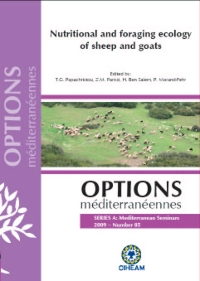| Article précédent | p. 261-266 | Article suivant |
In vitro gas production measurements and estimated energy value and microbial protein to investigate associative effects of untreated or biological treated linen straw and berseem hay
An in vitro gas production technique was used to investigate the associative effects of untreated or biologically-treated linen straw with berseem hay (H). The linen straw (LS) was biologically treated with white rot fungi (TLS). Ground samples (200 mg DM) of H, LS, TLS and the mixtures (50% w/w) of H + LS and H + TLS were incubated in 100 ml glass syringes with buffered rumen fluid. Cumulative gas production was recorded at 3, 6, 9, 12, 24, 48, 72 and 96 h of incubation and the kinetics of gas production was described by using the equation Gas (t) = b [1 - exp (-c (t - L))]. Gas production volume was highest for hay (P < 0.05) and greater for H + LS (P < 0.05) than LS and TLS. Total gas production at 96 h and rate of gas production increased when LS or TLS were mixed with hay. Metabolizable energy (ME) and net energy (NE) were higher (P < 0.01) for H, H + LS and H + TLS than for LS and TLS. Organic matter digestibility (OMD %) and microbial protein production were significantly higher for H, H + LS and H + TLS than for LS or TLS. In conclusion, positive associative effects on in vitro gas production occurred more consistently when untreated and biologically-treated linen straw was incubated in mixtures with hay.
La technique de production de gaz in vitro a été utilisée pour étudier les effets associatifs de la paille de lin (LS) non traitée ou traitée et le foin de Bersim (H). La paille de lin (PL) a été biologiquement traitée avec un champignon (TLS). Des échantillons broyés (200 mg de matière sèche) de H, LS, TLS et les mélanges (50% p/p) de H + LS et H + TLS ont été incubés dans des seringues en verre de 100 ml. Le volume de gaz produit dans chaque seringue a été enregistré après 3, 6, 9, 12, 24, 48, 72 et 96 h d'incubation et les cinétiques de production de gaz ont été modélisées selon le modèle suivant : Production de gaz (t) = b [1 - exp (-c (t - L))]. Le volume de gaz produit a été le plus élevé pour le foin (P < 0,05). Le substrat H + LS a produit plus de gaz (P < 0,05) que LS et TLS. Le volume total de gaz produit et la vitesse de production de gaz après 96 h d'incubation augmentent lorsque LS et TLS ont été mélangés avec le foin. L'énergie métabolisable (ME), l'énergie nette (NE), la digestibilité de la matière organique (OMD %) et la production de protéines microbiennes sont plus élevées avec H, H + LS et H + TLS qu'avec LS et TLS. En conclusion, les effets positifs sur la production de gaz in vitro sont obtenus lorsque la paille de lin non traitée ou traitée biologiquement est incubée en présence du foin.
- [ Afficher ]
- [ Télécharger ]
- [ Exporter la citation ]
Vous pouvez télécharger la citation au format :
- [ Imprimer ]
-
Mots-clés
DIGESTION DU RUMEN, EXPERIMENTATION IN VITRO, FERMENTATION, FOIN, FOURRAGE GROSSIER, LIN, MESURECiter cet article
Nasser M.E.A., El Waziry A.M., Sallam S.M.A. In vitro gas production measurements and estimated energy value and microbial protein to investigate associative effects of untreated or biological treated linen straw and berseem hay. In : Papachristou T.G. (ed.), Parissi Z.M. (ed.), Ben Salem H. (ed.), Morand-Fehr P. (ed.). Nutritional and foraging ecology of sheep and goats. Zaragoza : CIHEAM / FAO / NAGREF, 2009. p. 261-266. (Options Méditerranéennes : Série A. Séminaires Méditerranéens; n. 85). 12. Seminar on: Nutritional and Foraging Ecology of Sheep and Goats, 2007/10/11-13, Thessaloniki (Greece). http://om.ciheam.org/om/pdf/a85/00801015.pdf



